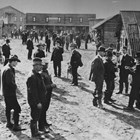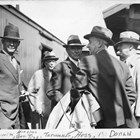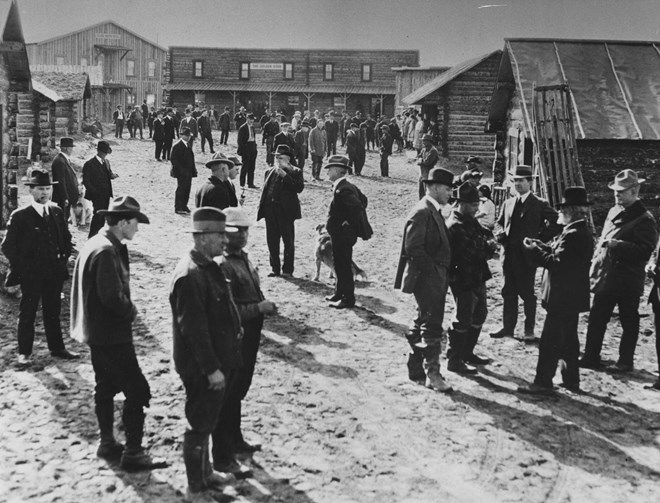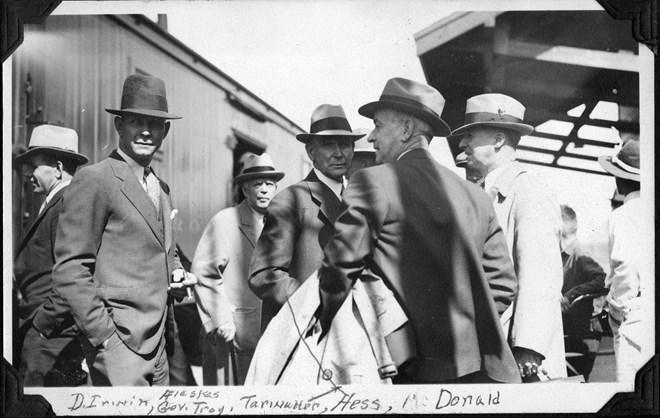Tarwater, Edgar R. "Tar"
1880-1944 | Banker, Investor, and Insurance Agent
Edgar Rule "Tar" Tarwater served the Bank of Alaska as manager of the Anchorage branch and as a vice president from 1925 to 1938. He was an invaluable part of the Anchorage branch and, with his associate George Mumford, is credited with providing a strong and enduring tradition of integrity and dependability. Eventually, the Bank of Alaska would become the National Bank of Alaska (1950-2000), the state’s oldest and largest bank. In 2000, the National Bank of Alaska was purchased by Wells Fargo. Tarwater’s great civic contribution was founding the Anchorage Golf Club and developing the city’s first golf course. Tarwater Avenue, in the Municipality of Anchorage, was named in his honor.1
Tennessee to Alaska
Edgar Rule “Tar” Tarwater was born on July 16, 1880 in Knoxville, Tennessee, to Henry Clark Tarwater and Harriett Mitchell Tipton Tarwater.
Edgar R. Tarwater worked as an employee for the U.S. Department of the Interior and the U.S. Department of War in the Philippine Islands from 1899 to 1914.2 He served as the U.S. Commissioner of Education on Luzon Island and, later, as a provisional treasurer for the U.S. Department of War. In 1914, he was transferred from the Philippine government service to the United States, where he accepted a position with the U.S. Reclamation Service.3 In 1915, he “spent a year on a world tour” before reporting to Alaska.4
Tarwater was employed by the Alaskan Engineering Commission (AEC) as a disbursing officer from 1916 to 1920. In 1916, he served as an assistant to Leslie Cramer at the Seattle Disbursing Office, through which financial settlement was made on the purchase of nearly all supplies for the construction of the Alaska Railroad.5 In 1917, he was assigned as the “special disbursing agent” to the AEC’s office in Seward.6 By 1919, he was working as the “Special Disbursing Agent and Chief Accountant.” While in Seward, he also went into banking as an employee at the Brown & Hawkins Bank.7 On August 1, 1920, the AEC closed its Seward office and Tarwater was transferred to Anchorage.8
Anchorage
By 1923-1924, Tarwater had left federal service to become the cashier of the Bank of Anchorage. The Bank of Anchorage, a branch of Brown & Hawkins’ Bank of Seward, opened for business on May 20, 1916, and was a competitor of the Bank of Alaska, the first bank to open in Anchorage.9 During its nine-year existence, the Bank of Anchorage appealed particularly to foreign railroad workers and advertised on its bank windows in various languages, including Italian, Russian, and Serbo-Croatian as well as English in an effort to increase its business.10 The Bank of Anchorage was located in the Alaska Building (at the corner of Fourth and G Streets) until it moved to the International Order of Odd Fellows (I.O.O.F.) Building in 1924. The Bank of Anchorage occupied the initial ground floor of the I.O.O.F. Building, also known as the Reed Building (614 West Fourth Avenue).11
In March 1925, following the decline of the Anchorage economy with the completion of the Alaska Railroad in 1923, the Bank of Anchorage closed. The Bank of Alaska purchased all of the assets of its former rival, consolidated operations, and then moved into the former quarters of the Bank of Anchorage in the Oddfellows Building. The Bank of Alaska had its headquarters in Skagway and also had two other branch offices in Cordova and Wrangell. It also owned the First National Bank of Ketchikan.
Tarwater joined the Bank of Alaska as the manager of the enlarged Anchorage branch, working with George Mumford, the assistant cashier of the Bank of Alaska in Anchorage since 1923. Tarwater and Mumford would become two of the bank’s most valuable and longest-serving employees.12 Before the merger of the two banks, Mumford and his wife, Jeanette, had been the only employees of the Anchorage branch of the Bank of Alaska.
As branch manager, Tarwater urged Bank of Alaska president E.A. Rasmuson to purchase radio advertising on station KFQD. KFQD signed on the air on May 17, 1924, and today is the oldest operating radio station in Alaska. Tarwater was an avid listener and aware of how many businesses were adapting to the new mass medium for advertising. In 1930, Tarwater proposed that the Bank of Alaska start advertising on radio for $55 per month as the sponsor of “Mr. Laughlin” on the pipe organ for a half hour each week. Tarwater explained to Rasmuson: “Practically all of the local merchants are taking advantage of this new form of advertising as well as the First National Bank. The local people are proud of this station, and from all reports it is bringing in some of the interior business to Anchorage.” Although KFQD’s signal had reportedly been received by radio set owners in communities all across Alaska and Canada, Rasmuson replied that he had never heard the Anchorage radio station on the family radio in Skagway. He also thought that radio advertising might work for such nationally known products as Pepsodent or Palmolive soap, but not for a small town bank. He considered such advertising to be “below the usual dignity of banks.”13
In September 1929, Edgar Tarwater and George Mumford completed the move of the Anchorage branch of the Bank of Alaska to the Peyser Building at the corner of Fourth and E Streets after a massive remodeling job. This was the exact location of the bank’s original location in May 1916, where it had first opened in a small shack of corrugated steel as the first bank in the entire city. The two-story building was used as a bank on the initial first floor and basement, with four rental apartments on the second floor. The Peyser Building would be the Anchorage home of the Bank of Alaska until 1963, when it was demolished and replaced by a new concrete structure.14
Tarwater had also sold insurance as a sideline activity while working for the Bank of Alaska. It was not uncommon in Alaska for small town bankers to write insurance policies, as it was convenient for both the bank and its customers. Before Tarwater, both George Munford in Anchorage and E.A. Rasmuson in Skagway sold insurance for many years.15 Tarwater became vice president of the Bank of Alaska and managed the Anchorage branch until he retired in 1938. After leaving the bank, Tarwater sold insurance for Gould and Gould. He also owned business properties on Fourth and Fifth Avenues.16 Tarwater’s last position was as superintendent of Merrill Field, which he held during World War II. His resignation from that position was reported to the city council on April 20, 1944, less than four months before his death.17
In 1928 Tarwater was elected to the Alaska House of Representatives as a Republican from Anchorage, and served in the Ninth Territorial Legislature from March 4 to May 2, 1929. In 1930, he was elected to the Anchorage City Council for a two-year term.
Along with other Anchorage friends and business associates of Wesley Earl Dunkle, Tarwater invested in the Golden Zone gold mine in the Broad Pass area of the central Alaska Range. Tarwater served as treasurer of a public stock corporation, Golden Zone Mine, Inc. (GMZ), headquartered in Alaska.18
In 1928 Tarwater and a group of other men formed the Anchorage Fur Farm Association, with famed dog musher Scotty Allen as one of the investors. The farm raised minks on an eight-acre tract at Tenth and M Street. When Norman Lange subdivided his homestead near Merrill Field he named one of the streets Tarwater Avenue. Tarwater was one of a loose group of Anchorage residents, primarily businessmen, who hired Nick Gaikema’s boat Sea Lion for forays to the west side of Cook Inlet to hunt waterfowl and play poker.
Tarwater was an ardent baseball fan and a dedicated golfer. He was a founding member of the Anchorage Golf Club and helped lay out the first golf course in Anchorage, which shared the same grounds as Anchorage’s first airstrip, located on what is today known as “the Delaney Park Strip” on Ninth Avenue between A and P Streets. When planes landed or took off the golfers were supposed to yield the right of way. In 1927 Tarwater battled his boss’s son, Elmer E. Rasmuson, to respectively take first and second place in the Governor’s Cup match. Tarwater also contributed to sports in Alaska by being an official for the 1917 and later the 1922 Fourth of July Mount Marathon Race in Seward. Tarwater was stationed at the top of the mountain, where he gave envelopes to the racers when they arrived, to prove that they had made it.19
Tarwater was president of the Anchorage Republican Club in 1926 and of the Alaska Chamber of Commerce in 1929.20
Tarwater apparently never married, and died in Seattle on August 5, 1944. He had been ill with a heart ailment for some six months before his death. He was interred at New Salem United Methodist Church Cemetery in Knoxville, Tennessee.21
Endnotes
- See, Charles Caldwell Hawley, Wesley Earle Dunkle: Alaska’s Flying Miner (Boulder: University Press of Colorado, 2003), 155; and Rae Arno, Anchorage Place Names: The Who and Why of Streets, Parks, and Places (Anchorage: Todd Communications, 2008), 73..
- Evangeline Atwood and Robert N. DeArmond, compilers, Who’s Who in Alaskan Politics: A Biographical Dictionary of Alaskan Political Personalities, 1884-1974 (Portland, OR: Binford & Mort for the Alaska Historical Commission, 1977), 98.
- “Departmental Notes of Interest,” Washington Post, May 24, 1914, 12.
- “E.R. Tarwater Dies in Seattle,” Anchorage Daily Times, August 7, 1944, 1.
- “Seattle Disbursing Office,” Alaska Railroad Record, v. 1, no. 6, December 19, 1916, 44.
- Entry for Edgar R. Tarwater, Official Register of the United States, 1816-1959, in U.S., Register of Civil, Military, and Naval Service, 1863-1959 [database on-line], http://ancestry.com (accessed October 25, 2014).
- Evangeline Atwood and Robert N. DeArmond, compilers, Who’s Who in Alaskan Politics: A Biographical Dictionary of Alaskan Political Personalities, 1884-1974, 98; and Rae Arno, Anchorage Place Names: The Who and Why of Streets, Parks and Places (Anchorage: Todd Communications, 2008), 73.
- Mary J. Barry, Seward, Alaska: A History of the Gateway City, Volume II: The Alaska Railroad Construction Years, 1914-1923 (Anchorage: Mary J. Barry, 1993), 26.
- Terrence Cole and Elmer E. Rasmuson, Banking on Alaska: The Story of the National Bank of Alaska, Volume 1: A History of NBA (Anchorage: National Bank of Alaska, 2000), 49-50; and Evangeline Atwood, Anchorage, Star of the North (Tulsa, OK: Continental Heritage Press, Inc., 1982), 57.
- Terrence Cole and Elmer E. Rasmuson, Banking on Alaska: The Story of the National Bank of Alaska, Volume 1: A History of NBA, 53, and 134-135.
- Michael Carberry and Donna Lane, Patterns of the Past: An Inventory of Anchorage’s Historic Resources (Anchorage: Community Planning Department, Municipality of Anchorage, 1986): 76.
- Terrence Cole and Elmer E. Rasmuson, Banking on Alaska: The Story of the National Bank of Alaska, Volume 1: A History of NBA, 134 and 143. George Mumford worked thirty-seven years for the Bank of Alaska, the longest tenure of any employee, when he retired in 1960.
- Ibid., 155-157.
- Ibid., 155.
- Ibid., 246.
- “E.R. Tarwater Dies in Seattle,” Anchorage Daily Times, August 7, 1944, 1.
- Minutes, December 28, 1942 and April 20, 1944, Anchorage City Council Minutes, Volumes V-VI, May 7, 1941-June 4, 1948 [microfilm edition], Alaska Collection, Z. J. Loussac Library, Anchorage Public Library
- Charles Caldwell Hawley, Wesley Earle Dunkle: Alaska’s Flying Miner, 154-155.
- Terrence Cole and Elmer E. Rasmuson, Banking on Alaska: The Story of the National Bank of Alaska, Volume 1: A History of NBA, 218-219; Mary J. Barry, Seward, Alaska: A History of the Gateway City, Volume II: 1914-1923, The Railroad Construction Years, 59.
- Evangeline Atwood and Robert N. DeArmond, compilers, Who’s Who in Alaskan Politics: A Biographical Dictionary of Alaskan Political Personalities, 1884-1974, 98.
- “E.R. Tarwater Dies in Seattle,” Anchorage Daily Times, August 7, 1944, 1; Edgar Tarwater, Washington, Deaths, 1883-1960 [database on-line], http://ancestry.com (accessed October 25, 2014); Edgar Rule Tarwater, Find A Grave Index, https://familysearch.org (accessed March 3, 2015).
Sources
This biographical sketch of Edgar R. Tarwater is based on an essay originally published in John Bagoy’s Legends and Legacies: Anchorage 1910-1935 (Anchorage, Publications Consultants, 2001), 265-266. See also the Edgar Tarwater file, Bagoy Family Pioneer Files (2004.11), Box 10, Atwood Resource Center, Anchorage Museum at Rasmuson Center, Anchorage, AK. Note: updated, revised, and expanded by Walter Van Horn and Bruce Parham. March 15, 2015.
Preferred citation: Walter Van Horn and Bruce Parham, “Tarwater, Edgar R. ‘Tar’,” Cook Inlet Historical Society, Legends & Legacies, Anchorage, 1910-1940, http://www.alaskahistory.org.
Major support for Legends & Legacies, Anchorage, 1910-1940, provided by: Anchorage Museum at Rasmuson Center, Atwood Foundation, Cook Inlet Historical Society, and the Rasmuson Foundation. This educational resource is provided by the Cook Inlet Historical Society, a 501 (c) (3) tax-exempt association. Contact us at the Cook Inlet Historical Society, by mail at Cook Inlet Historical Society, Anchorage Museum at Rasmuson Center, 625 C Street, Anchorage, AK 99501 or through the Cook Inlet Historical Society website, www.cookinlethistory.org.



